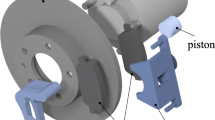Abstract
Tolerance design has a great impact on the cost and quality of a product. Previous research focused on process tolerances or robust tolerance design with little consideration on real manufacturing context. This paper presents a nonlinear method for robust tolerance design based on the real manufacturing context in three stages. The objective function to be minimized is the total manufacturing cost. The constraint equations for the optimization model are also deduced, which select suitable manufacturing processes based on the manufacturing environment. Simulation annealing (SA) is used for the nonlinear optimization. The approach is finally illustrated by a practical example. The results of the comparison with different models indicate that the proposed approach is more effective with the manufacturing resource. The robust and reliable tolerance can be obtained.
Similar content being viewed by others
References
Bjorke (1989) Computer-aided tolerancing, 2nd edn. ASME Press, New York
Wu ZT, Yang JX (1999) Computer-aided tolerance design. Zhejiang University Press, Hangzhou, China
Gao Y, Huang M (2003) Optimal process tolerance balancing based on process capabilities. Int J Adv Manuf Technol 21:501–507
Lee YC, Wei CC (1998) Process capability-based tolerance design to minimize manufacturing loss. Int J Adv Manuf Technol 14:33–37
Lee YH, Wei CC, Chang CL (1999) Fuzzy design of process tolerances to maximise process capability. Int J Adv Manuf Technol 15:655–659
Zhang Y, Fang XD (1999) Predict and assure the matchable degree in selective assembly via PCI-based tolerance. J Manuf Sci Eng 121:494–500
Huang PJ, Yang JX (2000) The research of the optimized process tolerance design based on process capacity index. Eng Des 3:45–47
Huang MF, Zhong YR (2007) Optimized sequential design of two-dimensional tolerances. Int J Adv Manuf Technol 33:579–593
Wei CC, Lee YC (1995) Determining the process tolerances based on the manufacturing process capability. Int J Adv Manuf Technol 10:416–421
Zhang G (1996) Simultaneous tolerancing for design and manufacturing. Int J Prod Res 34:3361–3382
Ji SP, Sun HW, Ma YL, Cai HG (2000) A new mathematical model for optimization of tolerance. J Haerbin Inst Technol 32(3):12–16
Wang BP, Zhang PK, Kong LD (2001) Investigation into cost tolerance model based on varying manufacture environment. J Taiyuan Heavy Mach Inst 22(3):204–207
Yan Y, Ning RX (2001) Process environment oriented concurrent tolerance analysis. J Beijing Inst Technol 10(2):157–162
Bras BA, Mistree F (1995) A compromise decision support problem for robust and axiomatic design. ASME J Mech Des 117(1):10–19
Jeang A (1999) Robust tolerance design by response surface methodology. Int J Adv Manuf Technol 15:399–403
Li W, Bai G, Zhang C, Wang B (2000) Optimization of machining datum selection and machining tolerance allocation with genetic algorithms. Int J Prod Res 38(6):1407–1424
Chang CL, Wei CC, Chen CB (2000) Concurrent maximization of process tolerances using grey theory. Robot Com Int Manuf 16:103–107
Peng HP, Jiang XQ, Xu ZG, Liu XJ (2007) Optimal tolerance design for products with correlated characteristics by considering the present worth of quality loss. Int J Adv Manuf Technol //DOI 10.1007/s00170-007-1205-7
Cao YL (2003) Study on the methodology and technology of robust tolerance design for manufacture. PhD Thesis, Zhejiang University, Hangzhou, China
Cisilino AP, Sensale B (2002) Application of a simulated annealing algorithm in the optimal placement of the source points in the method of the fundamental solutions. Comput Mech 28:129–136
Jiang LC, Liu JP (2007) Revised simulated annealing algorithm. Chin J Eng Geophys 4(2):35–40
Author information
Authors and Affiliations
Corresponding author
Rights and permissions
About this article
Cite this article
Mao, J., Cao, Y.L., Liu, S.Q. et al. Manufacturing environment-oriented robust tolerance optimization method. Int J Adv Manuf Technol 41, 57–65 (2009). https://doi.org/10.1007/s00170-008-1460-2
Received:
Accepted:
Published:
Issue Date:
DOI: https://doi.org/10.1007/s00170-008-1460-2




